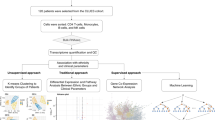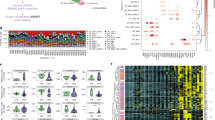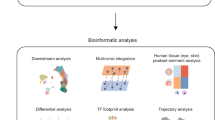Abstract
The aim of this study is to understand intracellular regulatory mechanisms in peripheral blood mononuclear cells (PBMCs), which are either common to many autoimmune diseases or specific to some of them. We incorporated large-scale data such as protein–protein interactions, gene expression and demographical information of hundreds of patients and healthy subjects, related to six autoimmune diseases with available large-scale gene expression measurements: multiple sclerosis (MS), systemic lupus erythematosus (SLE), juvenile rheumatoid arthritis (JRA), Crohn’s disease (CD), ulcerative colitis (UC) and type 1 diabetes (T1D). These data were analyzed concurrently by statistical and systems biology approaches tailored for this purpose. We found that chemokines such as CXCL1 -3, 5, 6 and the interleukin (IL) IL8 tend to be differentially expressed in PBMCs of patients with the analyzed autoimmune diseases. In addition, the anti-apoptotic gene BCL3, interferon-γ (IFNG), and the vitamin D receptor (VDR) gene physically interact with significantly many genes that tend to be differentially expressed in PBMCs of patients with the analyzed autoimmune diseases. In general, similar cellular processes tend to be differentially expressed in PBMC in the analyzed autoimmune diseases. Specifically, the cellular processes related to cell proliferation (for example, epidermal growth factor, platelet-derived growth factor, nuclear factor-κB, Wnt/β-catenin signaling, stress-activated protein kinase c-Jun NH2-terminal kinase), inflammatory response (for example, interleukins IL2 and IL6, the cytokine granulocyte–macrophage colony-stimulating factor and the B-cell receptor), general signaling cascades (for example, mitogen-activated protein kinase, extracellular signal-regulated kinase, p38 and TRK) and apoptosis are activated in most of the analyzed autoimmune diseases. However, our results suggest that in each of the analyzed diseases, apoptosis and chemotaxis are activated via different subsignaling pathways. Analyses of the expression levels of dozens of genes and the protein–protein interactions among them demonstrated that CD and UC have relatively similar gene expression signatures, whereas the gene expression signatures of T1D and JRA relatively differ from the signatures of the other autoimmune diseases. These diseases are the only ones activated via the Fcɛ pathway. The relevant genes and pathways reported in this study are discussed at length, and may be helpful in the diagnoses and understanding of autoimmunity and/or specific autoimmune diseases.
This is a preview of subscription content, access via your institution
Access options
Subscribe to this journal
Receive 6 digital issues and online access to articles
$119.00 per year
only $19.83 per issue
Buy this article
- Purchase on Springer Link
- Instant access to full article PDF
Prices may be subject to local taxes which are calculated during checkout






Similar content being viewed by others
References
Noel R, Rose IRM . The Aautoimmune Diseases. Academic Press New York, 2006.
Karopka T, Fluck J, Mevissen HT, Glass A . The autoimmune disease database: a dynamically compiled literature-derived database. BMC Bioinform 2006; 7: 325.
Jacobson DL, Gange SJ, Rose NR, Graham NM . Epidemiology and estimated population burden of selected autoimmune diseases in the United States. Clin Immunol Immunopathol 1997; 84: 223–243.
Marrack P, Kappler J, Kotzin BL . Autoimmune disease: why and where it occurs. Nat Med 2001; 7: 899–905.
Salaman MR . A two-step hypothesis for the appearance of autoimmune disease. Autoimmunity 2003; 36: 57–61.
Eisenbarth GS . Type 1 Diabetes: Molecular, Cellular and Clinical Immunology. Springer Berlin, 2004.
Lahita RG . Lupus: Systemic Erythematosus. Academic Press New York, 2003.
Prantera C, Korelitz BI . Crohn’s disease. Informa Health Care 1996; 8: 198–199.
Ó’Moráin CA . Ulcerative colitis. CRC Press Boca Raton, FL, 1991.
Earl J, Brewer EHG, Donald A . Person: Juvenile Rheumatoid Arthritis. Saunders Boston, MA, 1982.
Waxman SG . Demyelinating diseases—new pathological insights, new therapeutic targets. N Engl J Med 1998; 338: 323–325.
Noseworthy JH, Lucchinetti C, Rodriguez M, Weinshenker BG . Multiple sclerosis. N Engl J Med 2000; 343: 938–952.
Compston A, Coles A . Multiple sclerosis. Lancet 2002; 359: 1221–1231.
Nistala K, Wedderburn LR . Th17 and regulatory T cells: rebalancing pro- and anti-inflammatory forces in autoimmune arthritis. Rheumatology (Oxford) 2009; 48: 602–606.
Tsokos GC . Systemic lupus erythematosus. N Engl J Med 2011; 365: 2110–2121.
Crispin JC, Liossis SN, Kis-Toth K, Lieberman LA, Kyttaris VC, Juang YT et al. Pathogenesis of human systemic lupus erythematosus: recent advances. Trends Mol Med 2010; 16: 47–57.
Chan OT, Hannum LG, Haberman AM, Madaio MP, Shlomchik MJ . A novel mouse with B cells but lacking serum antibody reveals an antibody-independent role for B cells in murine lupus. J Exp Med 1999; 189: 1639–1648.
MacDonald TT, Murch SH . Aetiology and pathogenesis of chronic inflammatory bowel disease. Baillieres Clin Gastroenterol 1994; 8: 1–34.
Lehuen A, Diana J, Zaccone P, Cooke A . Immune cell crosstalk in type 1 diabetes. Nat Rev Immunol 2010; 10: 501–513.
Centola M, Frank MB, Bolstad AI, Alex P, Szanto A, Zeher M et al. Genome-scale assessment of molecular pathology in systemic autoimmune diseases using microarray technology: a potential breakthrough diagnostic and individualized therapy-design tool. Scand J Immunol 2006; 64: 236–242.
Achiron A, Gurevich M, Friedman N, Kaminski N, Mandel M . Blood transcriptional signatures of multiple sclerosis: unique gene expression of disease activity. Ann Neurol 2004; 55: 410–417.
Achiron A, Gurevich M, Snir Y, Segal E, Mandel M . Zinc-ion binding and cytokine activity regulation pathways predicts outcome in relapsing-remitting multiple sclerosis. Clin Exp Immunol 2007; 149: 235–242.
Baranzini SE, Mousavi P, Rio J, Caillier SJ, Stillman A, Villoslada P et al. Transcription-based prediction of response to IFNbeta using supervised computational methods. PLoS Biol 2005; 3: e2.
Gurevich M, Tuller T, Rubinstein U, Or-Bach R, Achiron A . Prediction of acute multiple sclerosis relapses by transcription levels of peripheral blood cells. BMC Med Genom 2009; 2: 46.
Bomprezzi R, Ringner M, Kim S, Bittner ML, Khan J, Chen Y et al. Gene expression profile in multiple sclerosis patients and healthy controls: identifying pathways relevant to disease. Hum Mol Genet 2003; 12: 2191–2199.
Whitney AR, Diehn M, Popper SJ, Alizadeh AA, Boldrick JC, Relman DA et al. Individuality and variation in gene expression patterns in human blood. Proc Natl Acad Sci USA 2003; 100: 1896–1901.
Barnes MG, Aronow BJ, Luyrink LK, Moroldo MB, Pavlidis P, Passo MH et al. Gene expression in juvenile arthritis and spondyloarthropathy: pro-angiogenic ELR+ chemokine genes relate to course of arthritis. Rheumatology (Oxford) 2004; 43: 973–979.
Mandel M, Gurevich M, Pauzner R, Kaminski N, Achiron A . Autoimmunity gene expression portrait: specific signature that intersects or differentiates between multiple sclerosis and systemic lupus erythematosus. Clin Exp Immunol 2004; 138: 164–170.
Kaizer EC, Glaser CL, Chaussabel D, Banchereau J, Pascual V, White PC . Gene expression in peripheral blood mononuclear cells from children with diabetes. J Clin Endocrinol Metab 2007; 92: 3705–3711.
Chaussabel D, Pascual V, Banchereau J . Assessing the human immune system through blood transcriptomics. BMC Biol 2010; 8: 84.
Compston A, Ebers G, Lassmann H, McDonald I, Matthews B, Wekerle H . McAlpine’s Multiple Sclerosis 1998.
Jarvis JN, Dozmorov I, Jiang K, Frank MB, Szodoray P, Alex P et al. Novel approaches to gene expression analysis of active polyarticular juvenile rheumatoid arthritis. Arthritis Res Ther 2004; 6: R15–R32.
Baechler EC, Batliwalla FM, Karypis G, Gaffney PM, Ortmann WA, Espe KJ et al. Interferon-inducible gene expression signature in peripheral blood cells of patients with severe lupus. Proc Natl Acad Sci USA 2003; 100: 2610–2615.
Aune TM, Maas K, Parker J, Moore JH, Olsen NJ . Profiles of gene expression in human autoimmune disease. Cell Biochem Biophys 2004; 40: 81–96.
Burczynski ME, Peterson RL, Twine NC, Zuberek KA, Brodeur BJ, Casciotti L et al. Molecular classification of Crohn’s disease and ulcerative colitis patients using transcriptional profiles in peripheral blood mononuclear cells. J Mol Diagn 2006; 8: 51–61.
Bovin LF, Brynskov J, Hegedus L, Jess T, Nielsen CH, Bendtzen K . Gene expression profiling in autoimmune diseases: chronic inflammation or disease specific patterns? Autoimmunity 2007; 40: 191–201.
Scherer A . Batch Effects and Noise in Microarray Experiments: Sources and Solutions. Wiley New York, 2009.
Tuller T, Atar S, Ruppin E, Gurevich M, Achiron A . Global map of physical interactions among differentially expressed genes in multiple sclerosis relapses and remissions. Hum Mol Genet 2011; 20: 3606–3619.
Alberts B, Johnson A, Lewis J, Raff M, Roberts K, Walter P . Molecular Biology of the Cell. New York, 2002.
Chuang HY, Lee E, Liu YT, Lee D, Ideker T . Network-based classification of breast cancer metastasis. Mol Syst Biol 2007; 3: 140.
Rutherford A . Introducing to ANOVA and ANCOVA a GLM Approach. SAGE Publication Inc Thousand Oaks, CA, 2001.
Fernandez EJ, Lolis E . Structure, function, and inhibition of chemokines. Annu Rev Pharmacol Toxicol 2002; 42: 469–499.
Rottman JB . Key role of chemokines and chemokine receptors in inflammation, immunity, neoplasia, and infectious disease. Vet Pathol 1999; 36: 357–367.
Ramagopalan SV, Heger A, Berlanga AJ, Maugeri NJ, Lincoln MR, Burrell A et al. A ChIP-seq defined genome-wide map of vitamin D receptor binding: associations with disease and evolution. Genome Res 2010; 20: 1352–1360.
Wulczyn FG, Naumann M, Scheidereit C . Candidate proto-oncogene bcl-3 encodes a subunit-specific inhibitor of transcription factor NF-kappa B. Nature 1992; 358: 597–599.
Gilmore TD . Introduction to NF-kappaB: players, pathways, perspectives. Oncogene 2006; 25: 6680–6684.
Eggleton P, Harries LW, Alberigo G, Wordsworth P, Viner N, Haigh R et al. Changes in apoptotic gene expression in lymphocytes from rheumatoid arthritis and systemic lupus erythematosus patients compared with healthy lymphocytes. J Clin Immunol 2010; 30: 649–658.
Achiron A, Feldman A, Mandel M, Gurevich M . Impaired expression of peripheral blood apoptotic-related gene transcripts in acute multiple sclerosis relapse. Ann N Y Acad Sci 2007; 1107: 155–167.
Nathan C . Points of control in inflammation. Nature 2002; 420: 846–852.
Chaussabel D, Quinn C, Shen J, Patel P, Glaser C, Baldwin N et al. A modular analysis framework for blood genomics studies: application to systemic lupus erythematosus. Immunity 2008; 29: 150–164.
Arasappan D, Tong W, Mummaneni P, Fang H, Amur S . Meta-analysis of microarray data using a pathway-based approach identifies a 37-gene expression signature for systemic lupus erythematosus in human peripheral blood mononuclear cells. BMC Med 2011; 9: 65.
Bossis G, Malnou CE, Farras R, Andermarcher E, Hipskind R, Rodriguez M et al. Down-regulation of c-Fos/c-Jun AP-1 dimer activity by sumoylation. Mol Cell Biol 2005; 25: 6964–6979.
Camargo JF, Correa PA, Castiblanco J, Anaya JM . Interleukin-1beta polymorphisms in Colombian patients with autoimmune rheumatic diseases. Genes Immun 2004; 5: 609–614.
Aradhya S, Nelson DL . NF-kappaB signaling and human disease. Curr Opin Genet Dev 2001; 11: 300–306.
Pena AS, Penate M . Genetic susceptibility and regulation of inflammation in Crohn’s disease. Relationship with the innate immune system. Rev Esp Enferm Dig 2002; 94: 351–360.
Yamamoto Y, Gaynor RB . Therapeutic potential of inhibition of the NF-kappaB pathway in the treatment of inflammation and cancer. J Clin Invest 2001; 107: 135–142.
Gabay C . Interleukin-6 and chronic inflammation. Arthritis Res Ther 2006; 8 (Suppl 2): S3.
Kristiansen OP, Mandrup-Poulsen T . Interleukin-6 and diabetes: the good, the bad, or the indifferent? Diabetes 2005; 54 (Suppl 2): S114–S124.
Tackey E, Lipsky PE, Illei GG . Rationale for interleukin-6 blockade in systemic lupus erythematosus. Lupus 2004; 13: 339–343.
Nishimoto N . Interleukin-6 in rheumatoid arthritis. Curr Opin Rheumatol 2006; 18: 277–281.
Woods JM, Katschke KJ, Volin MV, Ruth JH, Woodruff DC, Amin MA et al. IL-4 adenoviral gene therapy reduces inflammation, proinflammatory cytokines, vascularization, and bony destruction in rat adjuvant-induced arthritis. J Immunol 2001; 166: 1214–1222.
Wurster AL, Rodgers VL, White MF, Rothstein TL, Grusby MJ . Interleukin-4-mediated protection of primary B cells from apoptosis through Stat6-dependent up-regulation of Bcl-xL. J Biol Chem 2002; 277: 27169–27175.
Or R, Renz H, Terada N, Gelfand EW . IL-4 and IL-2 promote human T-cell proliferation through symmetrical but independent pathways. Clin Immunol Immunopathol 1992; 64: 210–217.
Besser M, Wank R . Cutting edge: clonally restricted production of the neurotrophins brain-derived neurotrophic factor and neurotrophin-3 mRNA by human immune cells and Th1/Th2-polarized expression of their receptors. J Immunol 1999; 162: 6303–6306.
Mandel M, Achiron A, Tuller T, Barliya T, Rechavi G, Amariglio N et al. Clone clusters in autoreactive CD4 T-cell lines from probable multiple sclerosis patients form disease-characteristic signatures. Immunology 2009; 128: 287–300.
Zhang N, Hartig H, Dzhagalov I, Draper D, He YW . The role of apoptosis in the development and function of T lymphocytes. Cell Res 2005; 15: 749–769.
Eguchi K . Apoptosis in autoimmune diseases. Intern Med 2001; 40: 275–284.
Baranzini SE . The genetics of autoimmune diseases: a networked perspective. Curr Opin Immunol 2009; 21: 596–605.
McDonald WI, Compston A, Edan G, Goodkin D, Hartung HP, Lublin FD et al. Recommended diagnostic criteria for multiple sclerosis: guidelines from the International Panel on the Diagnosis of Multiple Sclerosis. Ann Neurol 2001; 50: 121–127.
Best WR, Becktel JM, Singleton JW, Kern F . Development of a Crohn’s disease activity index. National Cooperative Crohn’s Disease Study. Gastroenterology 1976; 70: 439–444.
Schroeder KW, Tremaine WJ, Ilstrup DM . Coated oral 5-aminosalicylic acid therapy for mildly to moderately active ulcerative colitis. A randomized study. N Engl J Med 1987; 317: 1625–1629.
Aletaha D, Neogi T, Silman AJ, Funovits J, Felson DT, Bingham CO et al. Rheumatoid arthritis classification criteria: an American College of Rheumatology/European League Against Rheumatism collaborative initiative. Ann Rheum Dis 2010; 69: 1580–1588.
Rual JF, Venkatesan K, Hao T, Hirozane-Kishikawa T, Dricot A, Li N et al. Towards a proteome-scale map of the human protein–protein interaction network. Nature 2005; 437: 1173–1178.
Stelzl U, Worm U, Lalowski M, Haenig C, Brembeck FH, Goehler H et al. A human protein-protein interaction network: a resource for annotating the proteome. Cell 2005; 122: 957–968.
Peri S, Navarro JD, Amanchy R, Kristiansen TZ, Jonnalagadda CK, Surendranath V et al. Development of human protein reference database as an initial platform for approaching systems biology in humans. Genome Res 2003; 13: 2363–2371.
Xenarios I, Salwinski L, Duan XJ, Higney P, Kim SM, Eisenberg D . DIP, the Database of Interacting Proteins: a research tool for studying cellular networks of protein interactions. Nucleic Acids Res 2002; 30: 303–305.
Tuller T, Kupiec M, Ruppin E . Determinants of protein abundance and translation efficiency in S. cerevisiae. PLoS Comput Biol 2007; 3: e248.
Vogel C, Abreu Rde S, Ko D, Le SY, Shapiro BA, Burns SC et al. Sequence signatures and mRNA concentration can explain two-thirds of protein abundance variation in a human cell line. Mol Syst Biol 2010; 6: 400.
Dennis G, Sherman BT, Hosack DA, Yang J, Gao W, Lane HC et al. DAVID: Database for Annotation, Visualization, and Integrated Discovery. Genome Biol 2003; 4: P3.
Storey JD . A direct approach to false discovery rates. J R Statist Soc 2002; 64: 479–498.
Benjamini Y, Hochberg Y . Controlling the false discovery rate: a practical and powerful approach to multiple testing. J R Statist Soc 1995; 57: 289–300.
Shao J, Tu D . The Jackknife and Bootstrap. Springer Berlin, 1995.
Pedhazur EJ . Multiple Regression in Behavioral Research. Wadsworth Publishing Toronto, ON, Canada, 1997.
Author information
Authors and Affiliations
Corresponding author
Ethics declarations
Competing interests
The authors declare no conflict of interest.
Additional information
Supplementary Information accompanies the paper on Genes and Immunity website
Rights and permissions
About this article
Cite this article
Tuller, T., Atar, S., Ruppin, E. et al. Common and specific signatures of gene expression and protein–protein interactions in autoimmune diseases. Genes Immun 14, 67–82 (2013). https://doi.org/10.1038/gene.2012.55
Received:
Revised:
Accepted:
Published:
Issue Date:
DOI: https://doi.org/10.1038/gene.2012.55
Keywords
This article is cited by
-
JAK–STAT pathway targeting for the treatment of inflammatory bowel disease
Nature Reviews Gastroenterology & Hepatology (2020)
-
New Attempts to Define and Clarify Lupus
Current Rheumatology Reports (2019)
-
Sex-dependent effects of bisphenol A on type 1 diabetes development in non-obese diabetic (NOD) mice
Archives of Toxicology (2019)
-
Bisphenol A alteration of type 1 diabetes in non-obese diabetic (NOD) female mice is dependent on window of exposure
Archives of Toxicology (2019)
-
An integrative network-based approach to identify novel disease genes and pathways: a case study in the context of inflammatory bowel disease
BMC Bioinformatics (2018)



